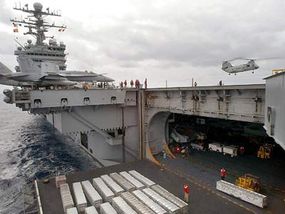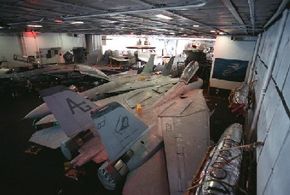The Hangar
The flight-deck crew can keep a small number of aircraft up top, but there's not nearly enough room for the 80 to 100 aircraft stationed on a typical carrier. When they're not in use, most of the aircraft are secured in the hangar bay, the "carrier's garage."
The hangar bay is located two decks below the flight deck, just below the galley deck. The bay itself is 110 feet (~34 m) wide, 25 feet (~8 m) high and 685 feet (~209 m) long -- more than two-thirds the length of the entire ship. It can hold more than 60 aircraft, as well as spare jet engines, fuel tanks and other heavy equipment, in four zones divided by sliding doors (a safety precaution to stop a fire from spreading).
Advertisement
The hangar is three decks high, and it's flanked by various single-deck compartments on both sides. There are also four giant elevators surrounding the hangar, which move the aircraft from the hangar to the flight deck. The high-speed, aluminum hydraulic elevators are big enough and powerful enough to lift two 74,000-pound (~34,000-kg) fighter jets.

Aft of the hangar bay, in the stern of the ship, you'll find the Aircraft Intermediate Maintenance Division (AIMD) shops. The men and women in these shops are constantly repairing and testing aircraft equipment to keep the flight squadron at full force. At the very end of the ship, the AIMD shops lead to an open-air engine testing area on the ship's fantail. This is the only place on the ship where the maintenance crews can safely blast aircraft jet engines to make sure they're working properly.

What's Onboard?
A major part of every aircraft carrier, logically, is the aircraft onboard. Carriers transport dozens of different aircraft specially designed to withstand the constant abuse of catapult takeoffs and arresting-wire landings. A carrier air wing typically consists of nine squadrons, with 70 to 80 total aircraft. The more notable onboard aircraft include:
- The F/A-18 Hornet - a single-seat strike fighter jet designed to take out enemy aircraft as well as ground targets
- The F-14 Tomcat - a two-seat fighter jet optimized for air superiority (A carrier's F-14 squadron is a crucial weapon in protecting the carrier battle group.)
- The E-2C Hawkeye - a tactical warning and control system aircraft (The aircraft's advanced radar system lets the air wing keep the fighter jets updated on enemy activity.)
- The S-3B Viking - a subsonic jet aircraft primarily used to take out enemy submarines
- The EA-6B Prowler - an electronic warfare aircraft (The Prowler's mission is to jam enemy radar and intercept enemy communications.)
- The SH-60 Seahawk - a twin-engine helicopter primarily used to attack enemy submarines and in search-and-rescue operations
